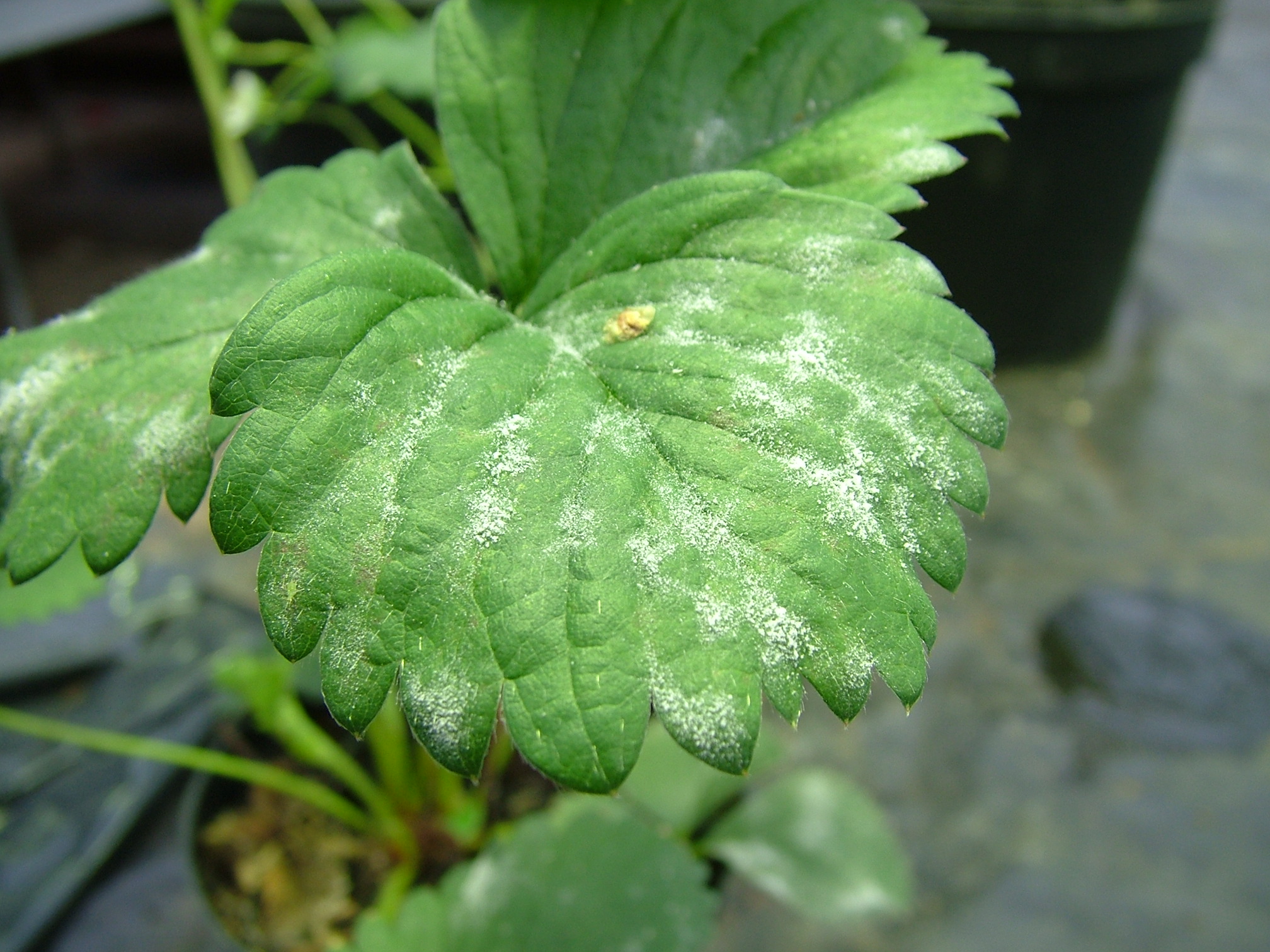Please click here to access the main AHDB website and other sectors.
- Home
- Knowledge library
- How to control strawberry powdery mildew
How to control strawberry powdery mildew
A new model has been developed to improve the management and control of strawberry powdery mildew and to predict periods when the crop is at risk of infection.
Located in Kent, the WET Centre is the perfect location to provide soft fruit growers a practical way to improve their crop quality and help control powdery mildew in strawberry crops.
The powdery mildew model relies upon the measurement of the numbers of hours of optimum temperature and humidity for disease development and helps growers to identify the best time to apply protective sprays to prevent infection from occurring. The system has been tested in commercial strawberry production where it helped to reduce the number of spray applications required to gain effective control.
Over the years, we have funded a number of projects to improve the management and control of strawberry powdery mildew.
In 2018, as part of AHDB Project ‘Improving integrated disease management in strawberry’, a managed approach to powdery mildew control was adopted in a crop of the everbearer strawberry variety Amesti at NIAB EMR. A standard 7-day fungicide programme was compared to a managed programme which uses control products only when the strawberry crop is at risk of infection. It is based upon visual inspection for incidence of strawberry powdery mildew, the environmental risk of mildew infection (which used the NIAB EMR strawberry powdery mildew model based on temperature and humidity records) and the strawberry growth stage.
The managed programme used significantly less spray applications, which reduced the cost by half compared to the standard 7-day fungicide programme. It was equally effective at maintaining control of powdery mildew.
In contrast to the standard 7-day fungicide programme where all permitted numbers of applications of the products had been made by the end of the season, far fewer applications had been made and a number were still available should late infection require additional control.

Demonstrating this approach at the WET Centre in 2019
A similar comparison is being demonstrated at the WET Centre in 2019 on the everbearer variety Malling Champion where six out of eight tunnel bays are being sprayed routinely for powdery mildew control and two out of eight are using the managed approach which is being overseen by Angela Berrie (NIAB EMR plant pathologist) and Alex Cooke (Berry Gardens agronomist).
The table below provides a summary of the number and choice of products applied in the routine programme and managed tunnels.
|
Routine programme
|
Managed programme |
||
|
Date |
Spray application |
Date |
Spray application |
|
26 April 19 |
Fortress – 0.25 litre/ha (quinoxyfen) |
26 April 19 |
Fortress – 0.25 litre/ha (quinoxyfen) |
|
3 May 19 |
Amistar Top - 1 litre/ha (difenoconazole & azoxystrobin) |
3 May 19 |
No risk – no spray |
|
10 May 19 |
Stroby WG – 0.3 kg/ha (kresoxim-methyl) |
10 May 19 |
No risk – no spray |
|
17 May 19 |
Fortress – 0.25 litre/ha (quinoxyfen) |
17 May 19 |
No risk – no spray |
|
24 May 19 |
Amistar Top - 1 litre/ha (difenoconazole & azoxystrobin) |
24 May 19 |
Amistar Top - 1 litre/ha (difenoconazole & azoxystrobin) |
|
31 May 19 |
Takumi SC – 150 ml/ha (cyflufenamid) |
31 May 19 |
No risk – no spray |
|
14 June 19 |
Takumi SC – 150 ml/ha (cyflufenamid) |
14 June 19 |
Takumi SC – 150 ml/ha (cyflufenamid) |
|
21 June 19 |
Topas – 0.5 litre/ha (penconazole) |
21 June 19 |
Topas – 0.5 litre/ha (penconazole) |
|
28 June 19 |
Charm – 0.6 litre/ha (difenoconazole & fluxapyroxad) |
28 June 19 |
Charm – 0.6 litre/ha (difenoconazole & fluxapyroxad) |
|
5 July 19 |
Topas – 0.5 litre/ha (penconazole) |
5 July 19 |
Topas – 0.5 litre/ha (penconazole) |
|
12 July 19 |
Luna Sensation – 0.8 litre/ha (fluopyram & trifloxystrobin) |
12 July 19 |
Potassium bicarbonate – 7.5 kg/ha |
|
15 July |
No spray |
15 July |
Luna Sensation – 0.8 litre/ha (fluopyram & trifloxystrobin) |
|
19 July |
Frupica – 0.9 litre/ha (mepanipyram) |
19 July |
Frupica – 0.9 litre/ha (mepanipyram) |
|
26 July |
Topas – 0.5 litre/ha (penconazole) |
26 July |
Topas – 0.5 litre/ha (penconazole) |
|
2 August |
Amylo X – 2.5 kg/ha (Bacillus amyloliquefaciens) |
2 August |
Amylo X – 2.5 kg/ha (Bacillus amyloliquefaciens) |
|
9 August |
Amylo X – 2.5 kg/ha (Bacillus amyloliquefaciens) |
9 August |
Amylo X – 2.5 kg/ha (Bacillus amyloliquefaciens) |
|
16 August |
Signum – 1.8 kg/ha (boscalid & pyraclotrobin) |
16 August |
Signum – 1.8 kg/ha (boscalid & pyraclotrobin) |
|
23 August |
Talius – 0.19 litre/ha (proquinazid) Potassium bicarbonate – 8 kg/ha |
23 August |
Talius – 0.19 litre/ha (proquinazid) Potassium bicarbonate – 8 kg/ha |
|
30 August |
Topas – 0.5 litre/ha (penconazole) |
30 August |
Topas – 0.5 litre/ha (penconazole) |
|
6 September |
Systhane – 0.3 litre/ha (myclobutanil) Signum – 1.8 kg/ha (boscalid & pyraclotrobin) |
6 September |
Systhane – 0.3 litre/ha (myclobutanil) Signum – 1.8 kg/ha (boscalid & pyraclotrobin) |
|
13 September |
Serenade – 10 litre/ha (Bacillus subtilis) |
13 September |
Serenade – 10 litre/ha (Bacillus subtilis) |
|
26 September |
Potassium bicarbonate – 8 kg/ha |
26 September |
Potassium bicarbonate – 8 kg/ha |

